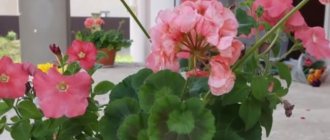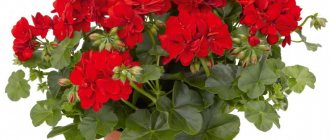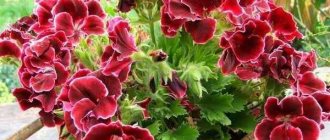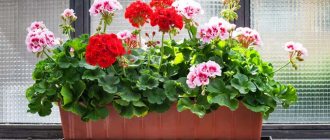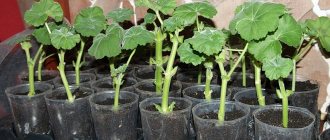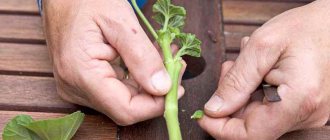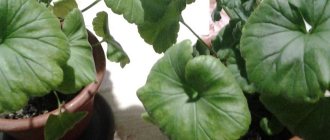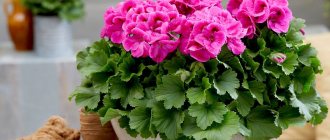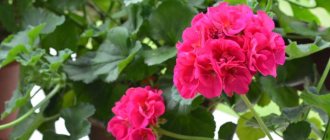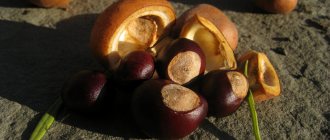- October 5, 2019
- Flowers
- KatrinGlamour
Pelargonium, which is better known to us as geranium, is one of the most picky plants, ideal for growing at home, on the terrace and in the garden. Every year this plant becomes more and more popular. And all thanks to the active breeding of new varieties that can surprise with their diversity. They all have different leaf shapes and an amazing range of flower colors. So pelargonium with unusual colors can easily compete with many exotic plants.
If you decide to get this plant, it will be useful for you to learn about the features of caring for and planting geraniums at home. By following a few simple rules, you can grow a flower that will delight you with its bright colors for a long time.
Popular varieties
Geranium is a very beautiful plant with a pleasant aroma. Thanks to its diversity, you can choose a bush with multi-colored buds, different leaves and flower shapes. Although only a few varieties are popular among domestic pelargonium lovers.
- Geranium is fragrant. It has a low stem and a fluffy crown. Has an unobtrusive pleasant aroma.
- Royal geranium. A tall plant with beautiful dense inflorescences. True, royal pelargonium does not bloom for very long.
- Geranium is zonal. The most popular plant that has small dense inflorescences and leaves with unusual circles. The flowers of this pelargonium are double and simple, and their color ranges from pale pink to deep red.
- Geranium "Angel". It grows up to 35-40 cm. Stripes or a dotted pattern appear on the upper petals of this geranium. Flowers at “Angel” are different: snow-white, purple, pink, red. Geranium of this variety blooms all summer and is considered one of the most unpretentious species.
- Pelargonium "Unicum". Reaches half a meter in height. It has a double color of flowers: the petals are white in the middle and purple or red at the edges. This variety has large dark green leaves.
- Ampelous geranium (ivy-leaved). It grows up to a meter and has ivy-like leaves, which is what it gets its name from. Flowers can be of any color, from snow-white to deep blue. The inflorescences are large, double and simple.
As you can see, there are many options. So you can easily choose a flower to your liking.
Types and varieties
Most often in home floriculture, zonal geranium, or kalachik, as it is still called in common parlance, is used. It is distinguished by dark concentric circles on the leaves, grows up to 30-60 cm in height, sometimes even up to a meter, blooms with simple or double bright flowers, collected in spherical umbrella inflorescences of red, crimson, white or pink.
Geranium ivy, or thyroid
An ampelous plant for hanging flowerpots with fragile hanging shoots up to a meter long and with racemose inflorescences of simple, semi-double and double flowers in a wide palette of colors.
Royal or English grandiflora geranium
It is homemade, royal noble) is represented by many varieties, shapes and colors, sometimes with variegated leaves, with simple and double flowers. The height of the plant is up to half a meter, and is distinguished by a dark spot or stripes along the veins on the lower petals.
In the photo: Ivy-leaved geranium
Fragrant geraniums
With the scent of lemon, almond, pepper, lemon balm, mint, ginger, pineapple, strawberry, coconut, pine when touched, the leaves are truly a miracle of nature, used to obtain geranium oil, valuable for the cosmetic, medical and food industries. Their flowers are small, pinkish or purple.
Angels
Geraniums, similar to pansies, bloom with hanging caps of inflorescences. They are compact bushes up to 30 cm high.
- How adenium blooms
In the photo: Royal geranium
Uniques
A hybrid of shiny and royal geraniums with strongly dissected leaves and a spicy scent. Flowers of incredible beauty are similar to the inflorescences of royal geranium.
Geraniums succulent
They are represented by 10 species: with spines, like cacti, and without spines. They are interesting for their decoratively curved stems, reminiscent of small baobabs. Used to create bonsai.
Landing Features
By growing a flower from seeds, you will get a viable, strong plant that will often delight you with abundant blooms. In the store you can find a huge assortment of pelargonium seeds, but keep in mind that not all of them are suitable for growing at home.
It's all about the specifics of selection. Flower hybrids are obtained through cross-pollination, due to which the plants become the owners of unique properties. They get an unusual shape or shade of leaves, the most amazing colors of buds. But these features are not passed on to subsequent generations, and the collected seeds produce completely different flowers. This is exactly what happens with rosaceous, royal, double and tulip-shaped varieties. So be on your guard.
But you can buy seeds of zonal and ampelous geraniums. By the way, ivy-leaved pelargonium has long, hanging stems that allow it to be grown in boxes or hanging containers on the terrace.
How to plant geranium? If pelargonium grows in a room, then it can be sown at any time. Although spring is still considered the best time to plant geraniums. Then the pelargonium will have time to gain strength and bloom by summer. After all, it is in warm times that geranium develops most actively, and in winter it needs rest.
If you want to decorate a balcony or terrace with a plant, you should plant it in January, February or March. Then by summer it will delight you with its lush blooms.
Geranium or pelargonium
Geranium is a perennial that is quite suitable for indoor growing. Depending on the species, it is a herbaceous plant or a subshrub. Botanists say that there are more than 250 species of geranium. In the wild, this plant grows in southern Africa. In our latitudes, geranium is a houseplant, and although there is a wild species, it does not have decorative qualities.
All homemade geraniums are divided into 2 groups: fragrant and flowering. Their difference is that the blooming ones, as the name implies, have very beautiful flowers. But the flowers of fragrant pelargoniums are inconspicuous. But the leaves have a unique, very strong aroma. Moreover, each subspecies has its own smell.
For example, the leaves of strong-scented geranium (Pelargonium graveolens) have a rose scent. And the smell that aromatic geranium (Pelargonium odoratissimum) gives off is reminiscent of the aroma of an apple. In a word, there are many types of geranium, they all smell differently and their smell is not always pleasant.
- Video about gerbera
But it is the aroma of the leaves that is associated with the beneficial effect of geranium on human health, because the leaves secrete phytoncides that kill pathogens and purify the air.
For many people, the aroma of geranium helps them relax and relieve fatigue. Pelargonium calms the nervous system and actually ionizes the air.
They say that the aroma of geranium is useful for patients who have suffered a stroke:
- it improves blood microcirculation in the heart muscle;
- helps with ischemia, sinus arrhythmia.
How to plant geraniums correctly
Pelargonium seeds germinate easily even without additional preparation. But for insurance purposes, they can be processed in advance.
First, the seeds need to be lightly filed with sandpaper or cut. Then they should be treated with a solution of potassium permanganate or a fungicide to prevent rotting.
You can germinate seeds in different ways:
- on a damp cotton pad or napkin;
- in special peat tablets;
- in the substrate.
You can make your choice at your own discretion - they are all equally good.
Caring for indoor geraniums
Geranium is a southern flower that loves the sun very much. In winter, geraniums should be placed in the brightest place in the house. In summer, geraniums are planted in the ground if possible. Staying in the fresh air is very beneficial for the plant: many new leaves and flowers appear.
Pelargonium grows well at temperatures around 20°C. But if it starts to get colder and cool nights set in with a temperature of 5-7°C, your main task is to protect the flower from drafts, otherwise it may get sick.
Water geraniums not too much, but regularly. The soil should always be slightly moist. In winter, watering is reduced.
In order for flowering geraniums to bloom profusely and brightly, you can feed them with fertilizers. Add liquid flowering plant food to the water you use to water your geraniums. You need to feed every 2 weeks in the summer. In winter, feeding is stopped.
- Ficus formation
Soil Features
Most ready-made substrates for indoor plants are suitable for growing pelargonium. You can prepare the mixture yourself by mixing sand, peat and garden soil in equal proportions. Just don't forget about drainage. The best soil for geraniums easily allows air and moisture to pass through and is loose.
Seeds should be placed in the soil to a depth of one centimeter. In this case, the soil must be moist. Be sure to cover the top of the container with film, which will need to be removed periodically to prevent rotting.
What soil composition is needed?
Geranium is a plant that is not picky about soil. But you shouldn’t buy just any one. It is advisable to follow certain recommendations when selecting it. So, what kind of soil should this houseplant be planted in?
Most often, gardeners buy universal soil, adding the necessary components to it . Vermiculite, river sand and perlite are suitable. All components are mixed and then poured into a pot of geranium. The main thing is to make sure that there is no mold or insects in the soil.
Reference. The flower grows well in loose and well-drained soil. You can buy special soil at a flower shop or prepare the substrate yourself.
Sometimes peat is added to the universal soil, which promotes the growth and development of the crop.
Watering mode
In summer, geraniums need moderate but frequent watering. Just keep in mind that the plant will not tolerate excess moisture and will die. Due to excessive watering, geranium leaves become too lethargic and begin to rot. If this symptom occurs, be sure to reduce watering. Otherwise, the root will soon begin to suffer.
But completely depriving geraniums of water is dangerous. It will most likely endure drought, but lush, beautiful flowers will no longer appear on its stems.
It is best to focus on the soil. As soon as you notice that it has dried out, water the pelargonium. But giving her water unnecessarily is undesirable.
Geranium diseases
Geranium rarely gets sick, but if this happens, it is usually caused by improper care. Sometimes the stem of young geraniums turns black (black rot). Such plants cannot be treated, they must be destroyed, and the soil in which the diseased specimens grew should be sterilized or replaced with new one. It is necessary to ensure that the soil does not become waterlogged - this is the cause of black, root and gray rot. Sometimes geraniums are affected by mites, whiteflies or aphids. If your geranium has mites or aphids, wash the leaves, especially carefully on the underside, with an infusion of chamomile or tobacco with green soap. After 2-3 hours, wash this mixture off the leaves with water. Treating the plant with preparations such as Zubr, Confidor, Actellik and Fufanon will help you get rid of whiteflies, all in turn, since getting rid of this pest and its larvae is not so easy.
- Indoor fern
Why does geranium turn yellow?
There may be several reasons why geranium leaves turn yellow:
- if only the edges of the leaves turn yellow and dry, it means the plant does not have enough moisture;
- if the yellowness of the leaves is accompanied by lethargy, then the reason is precisely in excess moisture;
- geraniums turn yellow and lose their lower leaves due to insufficient lighting;
- check if the pot has become too small for the plant;
- Sometimes the cause of yellowing and falling leaves may be adaptation when changing location or after replanting geraniums.
In the photo: Geranium turns yellow
Why doesn't geranium bloom?
Usually the reason why geraniums do not bloom is:
- too low temperature or lack of light. In such cases, it is necessary to provide additional illumination of the plant with fluorescent lamps;
- sometimes the culprit is too fertile soil, so try to buy a special substrate for geraniums or make it yourself according to the recipe from our article;
- the pot is too spacious, stimulating the growth of the root system, but inhibiting flowering;
- untimely pruning: geraniums need to be regularly “cut”, then they will branch more densely and bloom more luxuriantly;
- irregular feeding of geraniums.
Why does geranium dry out?
If only the tips of geranium leaves dry out, it means the plant does not have enough water. Another reason that geraniums dry out is the fungal disease rust: the leaves first become covered with red-brown spots, then begin to dry out and fall off. Spray the geranium with a five percent solution of Bordeaux mixture or treat it twice with phytosporin at intervals of 7-10 days.
In the photo: Geranium leaves drying
Lighting
Homemade geranium grows well if it does not feel a lack of light. So it’s best to place it near a south window.
Although it is possible to provide her with decent care in partial shade. It is not advisable to leave geraniums in direct sunlight. Otherwise, you are unlikely to be able to avoid the appearance of burns on its leaves. So don’t forget to periodically remove the plant from the windowsill.
But you shouldn’t grow geraniums in full shade either. In this case, the most beautiful thing you will see on it is the small leaves. Even with all its desire, without natural light, pelargonium will not be able to please you with abundant flowering.
Secrets of choosing the right soil for any plant
The best soil for pelargonium is not the same as the best soil for roses, azaleas or orchids. However, if we don’t touch exotics, then almost all soils have characteristics that unite them, knowledge of which will help you find the right soil among similar ones specifically for your plant.
The main characteristics of the soil include:
- porosity and looseness of the soil, which determine air penetration (soil aeration)
- ability to pass moisture (moisture permeability)
- ability to retain moisture (moisture capacity)
- nutrient conductivity
- acidity level - pH.
If Gloxinia, Hydrangea, Dieffenbachia require a slightly acidic environment (pH 6.0–6.5), then Rose, Cineraria, Chrysanthemum require a neutral environment (pH 6.5–7.0), and a slightly alkaline environment is suitable for Adenium and Narcissus. As a rule, the pH is indicated on the soil package.
Top dressing
Organic fertilizers should never be used to feed geraniums. It is best to saturate the soil with mixtures of potassium, phosphorus and nitrogen in equal proportions.
By feeding geranium with potassium, you will definitely wait for it to bloom. But be sure to control the amount of it in the fertilizers used - it should not be too large.
Proper care of pelargonium involves saturating the soil:
- calcium;
- zinc;
- manganese;
- copper;
- iron;
- magnesium;
- boron
To do this, it is best to use ready-made fertilizers for indoor plants. For example, an excellent option would be to use “Merry Flower Girl” or the “For Flowering Plants” mixture.
If it's hot outside, you shouldn't feed the geranium - it will be stressful for it. First, move the plant to the shade, and only then add fertilizer to the soil. At the same time, do not forget to water the flower in advance.
It is advisable to feed pelargonium twice a month. Nutrition is especially important for her in spring and summer.
Care Tips
Proper care of a plant is a whole complex of measures: proper watering and lighting, replanting and temperature conditions. Some useful tips:
- To prevent the soil from becoming compacted when watering and not moving away from the walls of the pot when it dries, coarse impurities are added: pebbles, crushed expanded clay, chopped moss, coarse sand, large brick or foam chips.
- Water the flower with a moderate amount of water at room temperature; do not “flood” the plant. In winter, this should be done no more than twice a week. In summer, when geranium is actively growing, daily watering is necessary, but without waterlogging, avoiding water getting on the leaves.
- The optimal temperature for the normal functioning of pelargonium: +18-22 degrees in summer and +10-15 degrees in winter. This is a fairly cold-resistant plant, but it needs a lot of light, even direct sunlight is acceptable, with the exception of particularly hot days.
- Geraniums are replanted in two cases: when the pot becomes crowded, and if a lot of water gets into it during watering. The approximate replanting schedule is once every 2-3 years, in spring or summer. It is better to choose pots that are not too spacious - this will worsen flowering.
- Mineral supplements are suitable as fertilizers, but it is better to refrain from fresh organic ones - the plant does not tolerate such fertilizing. During the period of rapid flowering, mixtures with a high content of potassium and phosphorus are used, and during the dormant period, nitrogen supplements are used. You need to fertilize the flower once a week, from late spring to early autumn. If the geranium has been replanted, it is better to start fertilizing after 2-3 months.
Methods for propagating geraniums
To obtain new flowers, you can use cuttings and dividing tubers. Moreover, the latter method is in demand for propagating garden plants, although, if you wish, you can use it at home.
But why do this if you can get a new bush by simply cutting cuttings? They need to be harvested in the spring.
How to plant geranium? To do this, shoots cut from the top of pelargonium should be placed in water. Keep in mind: the shoot must have at least 3-4 leaves.
At normal temperatures, cuttings grow roots very quickly. After this, the shoot can be moved to a pot with soil. Just before you transplant the cutting into the soil, let it dry out after watering it. Once it starts to grow in the pot, pinch off the top.
Now you know how to plant geraniums as simply as possible. If you do everything correctly, then from a small shoot in just a few months a large beautiful bush will grow, which will immediately delight you with its luxurious flowers.
Rules for caring for pelargonium seedlings at home
Under normal conditions, scarified seeds will germinate in 1-1.5 weeks after sowing, and regular seeds without treatment - in about 2-3 weeks. But the conditions should be as follows:
- Seeds need greenhouse conditions to germinate, i.e. high humidity and heat. Therefore, from the moment of planting until germination, the container must be covered with something (glass, film, lid).
- The container with soil and seeds should be kept in a room with a temperature of about 24-27 degrees Celsius.
- It is advisable to ventilate the container daily to avoid excessive moisture and mold. You literally need to remove the lid and film for 20-30 minutes.
- It is important to monitor soil moisture. As a rule, the soil does not have time to dry out before the first shoots, but if it starts to dry out, you will need to carefully moisten it with a spray bottle.
- When you see pelargonium shoots, you will need to remove the covering material forever. But it is advisable to do this gradually, over several days.
After the emergence of seedlings, the main task of the gardener is to concentrate on caring for pelargonium seedlings at home:
- Transfer the young plants to the sunniest windowsill or under phytolamps (if it is possible to turn them on for 12 hours a day). If even on the windowsill the seedlings do not have enough natural light, then they need to be additionally illuminated with phytolamps (this is especially true in winter and early spring). With a lack of light, geranium seedlings will begin to stretch.
- It is also necessary to change the temperature regime. Now the optimal temperature for seedlings is: +18-20°C during the day, +16-18°C at night.
- It is recommended to periodically (once every few days) turn the container with plants to the sunny side. This manipulation will avoid distortion of the seedlings, because they will be illuminated evenly.
- You need to be especially careful when watering geranium seedlings. Water the plants only when the top layer of soil dries out, not earlier. Excess moisture can cause fungal diseases, mold, and root rot. Lack of moisture is also dangerous, so the earthen ball should never dry out. The quality of the water is also important: it must be soft, clean, settled, and at room temperature.
- If you planted several seeds in one glass or pot, then you should leave only 1 strongest and strongest sprout.
How to replant geraniums
In fact, pelargonium is one of those plants that can easily do without replanting. But be that as it may, its condition should be checked periodically. Geraniums may need to be replanted when there is no room left in the pot for its roots.
Most often, pelargonium has to be replanted in adulthood. Although the plant may require this procedure if you regularly flood it with water.
In any case, to move geraniums you should choose a small flowerpot that will not differ much in size from its predecessor. When choosing a tub, take into account the volume of the plant’s root system.
Be sure to place drainage at the bottom of the pot. Geranium grows well even in ordinary garden soil, but you can pamper it by preparing a more nutritious mixture by hand. To do this, mix humus, sand, leaf and turf soil in equal proportions.
It is best to replant geraniums in the spring.
How to replant?
Geraniums are replanted when the root system grows strongly , when the flower is flooded and in the absence of buds. It is advisable to replant in the fall, before the plant enters the dormant stage. If you carry out the procedure in the spring, then only before its active growth.
- Before transplanting, prepare a tool (watering can, knife) and a pot. When using an old container, treat it with a chlorine-containing substance and then rinse it with water afterwards.
- Prepare high-quality drainage, positioning it so that ¼-1/5 of the pot is occupied.
- The geranium is taken out of the previous container, being careful not to damage the earthen ball. You can use a knife carefully if you need to separate the soil from the walls.
- After removing the geranium, inspect the roots, trying not to miss any traces of rot or strange spots. If they are present, remove them with scissors.
- Transfer the plant to a new pot, filling all the voids in it with soil.
- After watering, put the pelargonium in the shade for 7 days.
- After seven days, they place it on the windowsill, where there will be no bright light, drafts or heat from heating devices.
- Fertilizing is applied for the first time 2 months after transplantation.
Peculiarities
In Soviet times, almost every house had a window sill decorated with geraniums. Many people remember that this plant is unremarkable, but today’s varieties simply fascinate with their beauty and interesting color schemes, patterns on the leaves, and lush greenery. Every year the number of fans only increases, so it is worth considering in more detail how to replant indoor geraniums, as well as note the subtleties of caring for them.
Geranium is an unpretentious plant that does not require special care. The only danger for the flower is replanting, because if it is done incorrectly, the plant may even die. Indoor flowers need to be replanted for the following reasons:
- the plant grows, its root system cannot fit in a cramped pot;
- the soil loses nutrients, the plant needs new soil for normal growth and development.
Related article: How to grow fruit-bearing kiwi from seeds on a window: planting and care
Geraniums need to be replanted at home 2-3 times a year. But sometimes there are situations when a plant needs an unscheduled transplant. It is correct not to delay the transplantation in the following cases:
- when the pot becomes too small for the plant, roots are usually visible in the holes of the pot, and they are also visible on top of the substrate;
- if geranium receives proper care, but does not grow or bloom, the problem may lie in an incorrectly selected substrate;
- when geranium begins to wilt, its leaves turn yellow, and the soil cannot dry out completely, which is usually caused by rot of the root system;
- If you need to plant a plant from open ground in the fall in a pot for further cultivation at home.
Important! You should be very careful with geraniums, as they react quite painfully to transplantation. It is better not to resort to this procedure without a reason.
During flowering, the plant is strictly prohibited from touching. It is worth waiting for it to bloom, since the geranium is weakened at this time. As a result, she most likely will not be able to cope with the transplant: the buds will fall off, the leaves will turn yellow, and the flower may even die. There are cases when transplantation is very necessary, then only the transshipment method can be used. All actions should be performed carefully and carefully. If the transplant is carried out during flowering, then initially the flower stalks should be cut off, then all the energy will go exclusively to the development of the roots. Often a planned transplant is done in the spring or summer. In the cold season, you should refrain from such manipulation; for example, in January the plant needs additional feeding in order not to lose its attractive appearance, and replanting often becomes the impetus for its withering.
